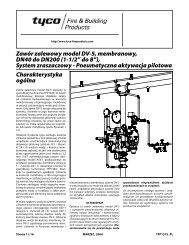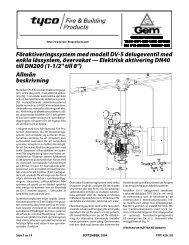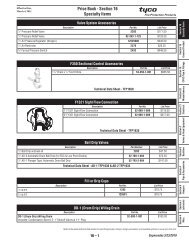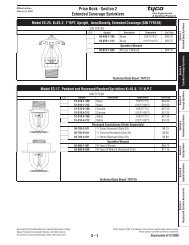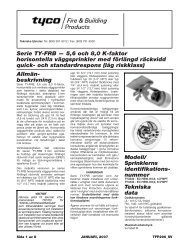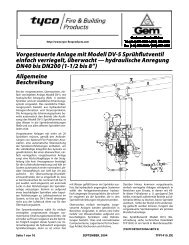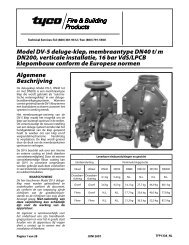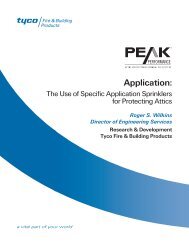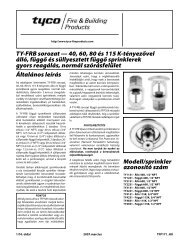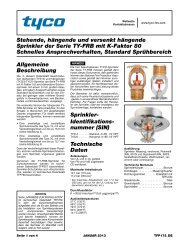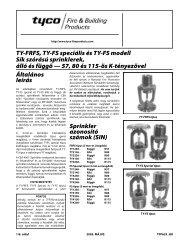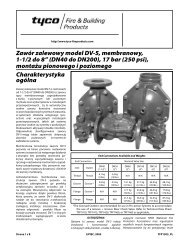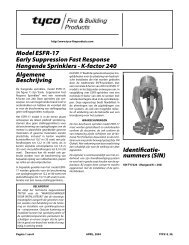1320.chp:Corel VENTURA - Tyco Fire Products
1320.chp:Corel VENTURA - Tyco Fire Products
1320.chp:Corel VENTURA - Tyco Fire Products
Create successful ePaper yourself
Turn your PDF publications into a flip-book with our unique Google optimized e-Paper software.
TFP1320<br />
Page 13 of 14<br />
by removing the clean-out plug and<br />
strainer basket. The Strainer may be<br />
flushed out by momentarily opening<br />
the Diaphragm Chamber Supply Control<br />
Valve.<br />
Step 6. Reset the actuation system.<br />
Manual Actuation — Push the operating<br />
lever up; however, do not close the<br />
hinged cover at this time.<br />
Electric Actuation — Reset the electric<br />
detection system in accordance with<br />
the manufacturer’s instructions to deenergize<br />
the solenoid valve.<br />
Step 7. Open the Diaphragm Chamber<br />
Supply Control Valve and allow time for<br />
full pressure to build up in the Diaphragm<br />
Chamber.<br />
Step 8. Operate (open) the Manual<br />
Control Station to vent trapped air from<br />
the Diaphragm Chamber. If necessary,<br />
first open the hinged cover, and then<br />
fully pull down on the operating lever.<br />
SLOWLY close the operating lever, by<br />
pushing it up, after aerated water<br />
ceases to discharge from the Manual<br />
Control Station drain tubing. Close the<br />
hinged cover and insert a new break<br />
rod in the small hole through the top of<br />
the enclosing box.<br />
Step 9. Inspect the drain connections<br />
from the Manual Control Station and<br />
Solenoid Valve. Any leaks must be corrected<br />
before proceeding to the next<br />
step.<br />
Step 10. Verify the ability for the DV-5<br />
Diaphragm to hold pressure as follows:<br />
With the diaphragm chamber pressurized<br />
per Step 8, temporarily close the<br />
Diaphragm Chamber Supply Control<br />
Valve, and monitor the Diaphragm<br />
Chamber Pressure Gauge for a drop in<br />
pressure.<br />
If a drop in pressure is noted, the DV-5<br />
Diaphragm is to be replaced and/or<br />
any leaks must be corrected before<br />
proceeding to the next step.<br />
If the Diaphragm Chamber Pressure<br />
Gauge indicates no drop in pressure,<br />
re-open the Diaphragm Chamber Supply<br />
Control Valve and proceed to the<br />
next step.<br />
Step 11. Slowly open the Main Control<br />
Valve. Close the Main Drain Valve as<br />
soon as water discharges from the<br />
drain connection. Observe the Automatic<br />
Drain Valve for leaks. If there are<br />
leaks, determine/correct the cause of<br />
the leakage problem. If there are no<br />
leaks, the DV-5 Valve is ready to be<br />
placed in service and the Main Control<br />
Valve must then be fully opened.<br />
NOTES<br />
When the Main Control Valve is<br />
opened, the pressure on the Diaphragm<br />
Chamber may increase. This<br />
increase in pressure is normal, and if<br />
the pressure is greater than 250 psi<br />
(17,2bar),thepressureistoberelieved<br />
by partially and temporarily<br />
opening the Manual Control Station;<br />
however, do not allow the pressure as<br />
indicated on the Diaphragm Chamber<br />
Pressure Gauge to drop below the<br />
supply pressure shown on the Water<br />
Supply Pressure Gauge, since this action<br />
may result in tripping of the DV-5<br />
Valve.<br />
After setting a fire protection system,<br />
notify the proper authorities and advise<br />
those responsible for monitoring<br />
proprietary and/or central station<br />
alarms.<br />
Care and<br />
Maintenance<br />
The following procedures and inspections<br />
must be performed as indicated,<br />
in addition to any specific requirements<br />
of the NFPA, and any impairment<br />
must be immediately corrected.<br />
The owner is responsible for the inspection,<br />
testing, and maintenance of<br />
their fire protection system and devices<br />
in compliance with this document,<br />
as well as with the applicable<br />
standards of the National <strong>Fire</strong> Protection<br />
Association (e.g., NFPA 25), in<br />
addition to the standards of any<br />
authority having jurisdiction. The installing<br />
contractor or product manufacturer<br />
should be contacted relative to<br />
any questions.<br />
It is recommended that automatic<br />
sprinkler systems be inspected,<br />
tested, and maintained by a qualified<br />
Inspection Service in accordance with<br />
local requirements and/or national<br />
codes.<br />
NOTES<br />
Some of the procedures outlined in<br />
this section will result in operation of<br />
the associated alarms. Consequently,<br />
notification must first be given to the<br />
owner and the fire department, central<br />
station, or other signal station to which<br />
the alarms are connected.<br />
When the system is using either a<br />
seawater or brackish water supply, internal<br />
and external inspection of the<br />
DV-5 Valve and Trim is essential.<br />
Parts showing any signs of corrosion<br />
must be replaced to ensure the integrity<br />
of the system.<br />
Before closing a fire protection system<br />
main control valve for maintenance<br />
work on the fire protection system that<br />
it controls, permission to shut down the<br />
affected fire protection systems must<br />
first be obtained from the proper<br />
authorities and all personnel who may<br />
be affected by this action must be notified.<br />
Reset the Model DV-5 Deluge<br />
Valve in accordance with the Valve<br />
Setting Procedure section.<br />
Annual Operation Test Procedure<br />
Proper operation of the DV-5 Valve<br />
(i.e., opening of the DV-5 Valve as during<br />
a fire condition) must be verified at<br />
least once a year as follows:<br />
Step 1. If water must be prevented<br />
from flowing beyond the riser, perform<br />
the following steps.<br />
• Close the Main Control Valve. Open<br />
the Main Drain Valve.<br />
• Open the Main Control Valve one<br />
turn beyond the position at which<br />
water just begins to flow from the<br />
Main Drain Valve.<br />
• Close the Main Drain Valve.<br />
Step 2. Test the deluge releasing<br />
panel in accordance with the manufacturer’s<br />
instructions to energize the solenoid<br />
valve.<br />
NOTE<br />
Be prepared to quickly perform Steps<br />
3, 4, and 5, if water must be prevented<br />
from flowing beyond the riser.<br />
Step 3. Verify that the DV-5 Valve has<br />
tripped, as indicated by the flow of<br />
water into the system.<br />
Step 4. Close the system’s Main Control<br />
Valve.<br />
Step 5. Close the Diaphragm Chamber<br />
Supply Control Valve.<br />
Step 6. Reset the DV-5 Deluge Valve<br />
in accordance with the Valve Setting<br />
Procedure.<br />
Quarterly Waterflow Alarm Test<br />
Procedure<br />
Testing of the system waterflow alarms<br />
must be performed quarterly. To test<br />
the waterflow alarm, open the Alarm<br />
Test Valve, which will allow a flow of<br />
water to the Pressure Alarm Switch<br />
and/or Water Motor Alarm. Upon satisfactory<br />
completion of the test, close<br />
the Alarm Test Valve.<br />
Quarterly Solenoid Valve Test Procedure<br />
For Electric Actuation<br />
Proper operation of the Solenoid Valve<br />
for electric actuation must be verified<br />
at least quarterly as follows:<br />
Step 1. Close the Main Control Valve.<br />
Step 2. Open the Main Drain Valve.<br />
Step 3. Test the deluge releasing<br />
panel in accordance with the manufac-



